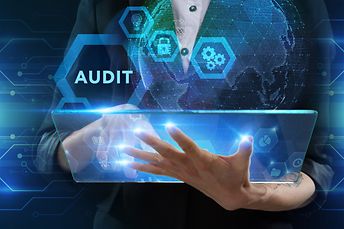The Path to a Successful Information Security Audit: A Strategic Look Behind the Scenes
For many companies, an information security audit can feel like a stress test – an examination that determines whether the security concept is truly sound. But rather than viewing audits as "stress," forward-thinking companies see them as an opportunity to reflect on the current threat landscape and proactively improve security measures. At SSI SCHAEFER, we understand that securing systems isn't just about passing an audit but about building a solid foundation for future success in an increasingly interconnected world.
But how can you strategically prepare for an audit to not only meet compliance requirements, but also minimize real risks?
Building a secure foundation
As an intralogistics company, SSI SCHAEFER deals with valuable assets—whether it's handling physical inventory, managing automated systems, or monitoring data related to logistics processes. To ensure everything is protected, you wouldn’t just lock the front door – you would also install security cameras, restrict access to sensitive areas, and continuously monitor for potential threats. This multi-layered approach to physical security is equally essential in information security. SSI SCHAEFER relies on both preventive and detective controls throughout its processes to detect and mitigate hacker threats at an early stage.
A key standard for structuring this approach is ISO/IEC 27001, which provides a clear framework for an information security management system (ISMS).
Strengthening access control
One of the first areas auditors examine is access control: Who has authorization to access critical systems? Two fundamental principles are particularly important:
"Need to know" principle: Employees are granted access only to the information they need to perform their duties.
"Segregation of duties" principle: Critical functions are separated—for example, a person may be allowed to modify supplier data but not authorize payments.
By adding multi-factor authentication (MFA), users don’t just rely on a password, but they also need at least one additional factor, such as a software token on their smartphone. MFA has become essential even in personal settings. The use of additional apps or SMS codes for everyday services like online banking, social media platforms, or email programs makes it significantly harder for unauthorized parties to access accounts.
In addition to digital access control, physical access control is something we’re all familiar with in our daily work environment. Access cards and keys enable secure access to rooms and buildings. Visitors are signed in and out using visitor logs, and guests are only allowed on the premises if accompanied. The combination of all these measures creates a "multi-layered" security approach.
Always staying one step ahead
An information security audit doesn’t just assess where you stand today but also evaluates how well prepared you are for tomorrow’s threats. That’s why auditors place particular emphasis on software updates and patch management. Cybercriminals are constantly looking for vulnerabilities in outdated systems, and an unpatched software flaw can become the weakest link in an otherwise strong defense. At SSI SCHAEFER, we take a security approach that includes proactive system updates and automated patch management to ensure that the infrastructure is always protected against new threats.
The human factor as a critical element
Security tools and technologies alone are not enough to fully protect a company. People play an equally critical role in cybersecurity. One of the most common red flags in audits isn’t a system vulnerability, but rather a lack of employee awareness. Social engineering attacks, phishing emails, and weak passwords remain among the leading causes of security incidents.
Companies that invest in ongoing cybersecurity training foster a culture of vigilance. Regular phishing simulations and security awareness training empower employees to recognize threats early and respond effectively. At SSI SCHAEFER, we have implemented a comprehensive online training program to strengthen cybersecurity awareness among our employees. The training covers topics such as phishing detection, password security, and safe online practices, ensuring our teams remain vigilant against emerging threats. This knowledge can be readily applied in everyday life, both for personal safety and for protecting one’s family.
Data protection: More than just encryption
Data security is another key focus during audits. Auditors look closely at how data is classified, stored, and transmitted. Are backups securely managed? Are sensitive customer data protected from unauthorized access? Is the data encrypted? ISO/IEC 27001 emphasizes a holistic approach to data security, covering everything from encryption protocols to the secure storage and disposal of sensitive information. A comprehensive data protection strategy ensures that even in the event of a security breach, critical information remains protected.
Continuous monitoring: The key to proactive security
Information security is not a one-time effort. It requires ongoing monitoring and adjustment. Auditors evaluate whether companies have real-time security monitoring tools in place. These solutions provide visibility into network activity, detect anomalies, and enable a rapid response to potential threats.
ISO/IEC 27001 also requires the implementation of a risk management process that continuously identifies and minimizes security risks. By integrating proactive monitoring into a structured ISMS, companies can demonstrate to auditors that they are not only reacting to security incidents but actively taking steps to prevent them.
From regulatory compliance to competitive advantage
Ultimately, information security audits are not just about meeting regulatory requirements. They are also about building trust. Employees, customers, and partners want to know that their data is in safe hands. When companies approach audits with a strategic mindset, they can turn them into opportunities for growth while strengthening their reputation and resilience in an increasingly digital world. SSI SCHAEFER goes beyond mere compliance with security standards by implementing targeted measures that ensure warehouse managers have a reliable partner for their storage and logistics processes.

About the authors:


Sari Leino joined SSI Schaefer in August 2022 as Information Security Manager in the Group Information Security Team. She holds a Master of Science in Information Systems, a Postgraduate Certificate in Business Administration and is a Certified Information Systems Auditor (CISA). Her expertise includes governance, risk management, compliance, auditing, consulting and certification. At SSI Schaefer, her focus is on further developing global security frameworks, supporting compliance activities and implementing risk-based improvements across the organization.